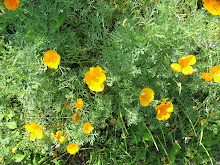Since then, a few weeks have passed without a cent going directly into my gardening costs. But now, I can begin estimating my yield. In recent posts I've reported that my family and I have already started enjoying some of the lettuce and spinach. What we began eating every few days has now become what rice is to many other cultures. Now salads must be consumed every day, and no sandwich is permitted to be made without a layer of green. Anyone who walks in the door of our home will not be allowed out without a recycled takeout container of the most recent harvest.
 But before I continue on this subject, I'd like to ask: What has happened to some of my spinach? I returned to the Minton Stable Garden yesterday after a few days away to find an ugly blight. Some of the leaves appeared bleached out, while others displayed what looked like bird droppings. I doubt that a flock of birds would hover over a row of spinach and leave the rest of the garden untouched. My husband's theory based on his past experience (although he's away for work and unable to see the problem, let alone meet his salad quota) is that it may be a fungus. From a search through my books and the Internet I learned that too much moisture lingering on spinach leaves can lead to diseases such as Anthracnose (which comes closest to resembling what mine have) and the more threatening-looking blue mold. The rainy, chilly weather of the past few days may be to blame. I bagged up the affected leaves and discarded them. End of story, I hope.
But before I continue on this subject, I'd like to ask: What has happened to some of my spinach? I returned to the Minton Stable Garden yesterday after a few days away to find an ugly blight. Some of the leaves appeared bleached out, while others displayed what looked like bird droppings. I doubt that a flock of birds would hover over a row of spinach and leave the rest of the garden untouched. My husband's theory based on his past experience (although he's away for work and unable to see the problem, let alone meet his salad quota) is that it may be a fungus. From a search through my books and the Internet I learned that too much moisture lingering on spinach leaves can lead to diseases such as Anthracnose (which comes closest to resembling what mine have) and the more threatening-looking blue mold. The rainy, chilly weather of the past few days may be to blame. I bagged up the affected leaves and discarded them. End of story, I hope.Now, back to the healthy greens harvested--how much are they worth? Since I've been picking leaves and not whole heads or bunches, I'll base my estimation on my experience buying a similar organic product. At this point my daughter and I have picked the equivalent of one container of Olivia's Organics salad mix, perhaps a combination of their Romaine and Spinach products, or another mix. I believe that the last time I saw it at the Harvest Coop in JP it was priced at $3.59 a container, so I'll make the not-so-scientific assumption that I have saved that much in my food budget. So my total monetary benefit of my vegetable and fruit gardening is so far:
1 container* of salad greens $3.59**
*According to the web site, the size is 6/5 ounces.
**In Massachusetts, food from the grocery is not taxed.
 I have never been good at making quick decisions, but I had promised myself that by the end of the post I would be able to jump off the fence in one direction or the other. Will the value of my harvest exceed my expenses? My guess is now...maybe next year.
I have never been good at making quick decisions, but I had promised myself that by the end of the post I would be able to jump off the fence in one direction or the other. Will the value of my harvest exceed my expenses? My guess is now...maybe next year.As I finish this up it has begun to rain again in Boston. You might find me in the MSG tomorrow wiping off my spinach. In the meantime, I'll leave you with an image of what's coming into bloom: lupines and poppies from another gardener's plot.
















